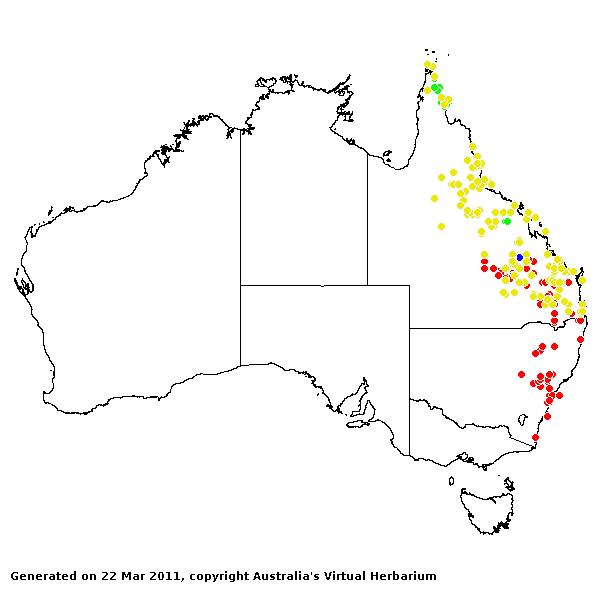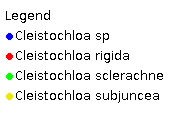Cleistochloa Hooker's Icon. Pl. 33: 3209 (1933).
Derivation:. From Greek kleistos (enclosed) and chloe (grass), referring to some of the spikelets being cleistogamous.
Syn: Dimorphochloa S.T.Blake.
Taxonomic revisions, nomenclatural references:. C.E.Hubbard, Hookers Icones Plantarum 33: t.3209: 1–6 (1933).
Key references (keys and floras):. J.W.Vickery, Flora of New South Wales, Gramineae 19: 68–69(1961) and 66–67as Dimorphochloa; E.E.Henty, Manual Grasses New Guinea 51 (1969); M.Lazarides, Tropical Grasses S.E. Asia 110–111 (1980); J.C.Tothill and J.B.Hacker, Grasses of Southern Queensland 164–165 (1983) and 198–199 as Dimorphochloa; R.D.Webster, Australian Paniceae 30–33 (1987); B.K.Simon, Key to Australian Grasses 86 (1993); S.W.L.Jacobs and C.A.Wall, Flora of New South Wales 4: 449–450 (1993); D.Sharp and B.K.Simon, AusGrass (2002); S.W.L.Jacobs, R.D.B.Whalley & D.J.B.Wheeler, Grasses of New South Wales, 4th Ed, 187–188 (2008).
W.D.Clayton & S.A.Renvoize, Genera Graminum (1986), genus (470).
Native. 4 species. Qld and NSW. Also New Guinea.
Habit. Perennial, tufted. Culms wiry. Leaf blades narrow. Ligule a fringe of hairs. Hidden cleistogenes in leaf sheaths (borne singly, highly modified).
Inflorescence. Inflorescence a single raceme (spike-like, terminating culm branches), of two types.
Spikelets. Spikelets dorsally compressed, 2 flowered, with 1 fertile floret, solitary, pedicelled (the pedicels very short). Fertile spikelets with lower incomplete floret(s), oblong or elliptic or obovate, adaxial (with lower glume against rachis), falling with glumes.
Glumes. Glumes one per spikelet or two (the lower minute or absent), (the upper) relatively large, unequal, shorter than adjacent lemmas, rounded, awnless, dissimilar (lower glume minute). Lower glume 0 nerved. Upper glume 5–7 nerved.
Florets. Lower incomplete floret(s) sterile. Lemmas awnless (hairy on margins and apex), 7 nerved, more or less equalling fertile lemmas, less firm than fertile lemmas to similar in texture to fertile lemmas, not becoming indurated. Fertile florets 1. Lemmas similar to the lower lemma, striate, not becoming indurated, yellow in fruit or brown in fruit, entire at apex, blunt, muticous, with a clear germination flap, 5–7 nerved, having flat margins not tucked into palea. Palea relatively long (margins hairy towards apex), entire (subacuminate), 2 nerved. Lodicules 2. Stamens 3. Grain small. Hilum short. Embryo large.
Kranz Anatomy. C3.
Habitat. Xerophytic. Dry sandstone. Species of open habitats.
Classification. Panicoideae; Paniceae.
Notes. Cleistogenes appear to be the normal mode of reproduction, supplemented by chasmogamous inflorescences when rainfall is adequate (Clayton and Renvoize, 1986).
Types Species. C. hubbardiana Henrard.
Biogeographic Element. Clifford & Simon 1981, Simon & Jacobs 1990: Australasian.


